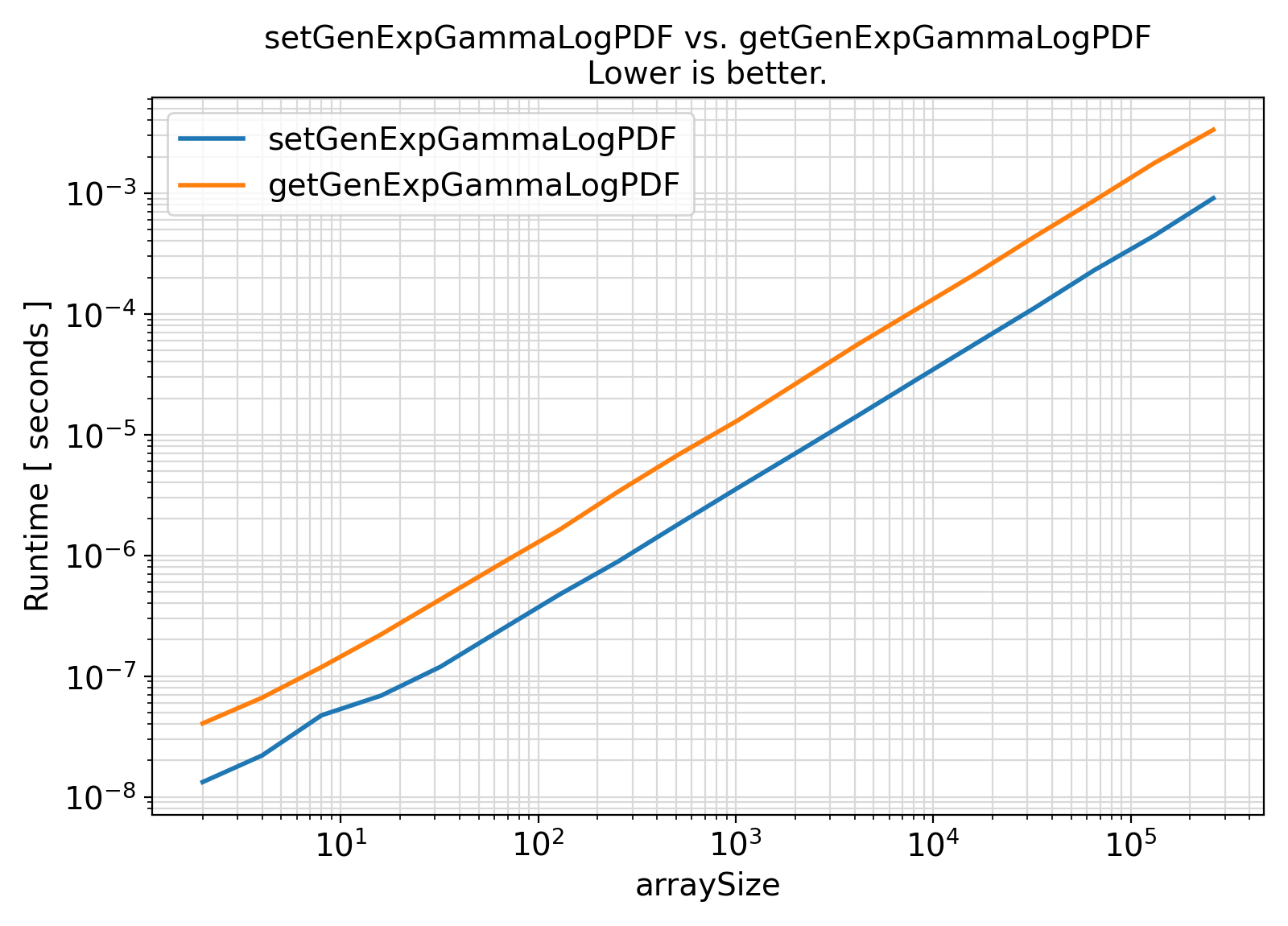
|
ParaMonte Fortran 2.0.0
Parallel Monte Carlo and Machine Learning Library
See the latest version documentation. |

|
ParaMonte Fortran 2.0.0
Parallel Monte Carlo and Machine Learning Library
See the latest version documentation. |
This module contains classes and procedures for computing various statistical quantities related to the GenExpGamma distribution. More...
Data Types | |
| type | distGenExpGamma_type |
| This is the derived type for signifying distributions that are of type GenExpGamma as defined in the description of pm_distGenExpGamma. More... | |
| interface | getGenExpGammaCDF |
Generate and return the Cumulative Distribution Function (CDF) of the GenExpGamma distribution for an input x within the support of the distribution \(x \in (-\infty,+\infty)\). More... | |
| interface | getGenExpGammaLogPDF |
| Generate and return the natural logarithm of the Probability Density Function (PDF) of the GenExpGamma distribution. More... | |
| interface | getGenExpGammaLogPDFNF |
| Generate and return the natural logarithm of the normalization factor of the Probability Density Function (PDF) of the GenExpGamma distribution. More... | |
| interface | setGenExpGammaCDF |
Return the Cumulative Distribution Function (CDF) of the GenExpGamma distribution for an input x within the support of the distribution \(x \in (-\infty,+\infty)\). More... | |
| interface | setGenExpGammaLogPDF |
| Return the natural logarithm of the Probability Density Function (PDF) of the GenExpGamma distribution. More... | |
Variables | |
| character(*, SK), parameter | MODULE_NAME = "@pm_distGenExpGamma" |
This module contains classes and procedures for computing various statistical quantities related to the GenExpGamma distribution.
Specifically, this module contains routines for computing the following quantities of the GenExpGamma distribution:
A variable \(X\) is said to be GenExpGamma-distributed if its PDF with location \(-\infty < \log(\sigma) < +\infty\), scale (inverse rate) \(\omega > 0\), and shape \(\kappa > 0\) parameters is described by the following equation,
\begin{equation} \large \pi(x | \kappa, \omega, \log(\sigma)) = \frac{1}{\omega \Gamma(\kappa)} ~ \exp\Bigg( \kappa\bigg(\frac{x - \log(\sigma)}{\omega}\bigg) - \exp\bigg(\frac{x - \log(\sigma)}{\omega}\bigg) \Bigg) ~,~ -\infty < x < \infty \end{equation}
where \(\eta = \frac{1}{\omega \Gamma(\kappa)}\) is the normalization factor of the PDF.
When \(\sigma = 1\), the GenExpGamma PDF simplifies to the form,
\begin{equation} \large \pi(x) = \frac{1}{\omega \Gamma(\kappa)} ~ \exp\Bigg(\kappa \frac{x}{\omega} - \exp\bigg(\frac{x}{\omega}\bigg) \Bigg) ~,~ -\infty < x < \infty \end{equation}
If \((\sigma, \omega) = (1, 1)\), that is, \(x\) is standardized, the GenExpGamma PDF further simplifies to the form,
\begin{equation} \large \pi(x) = \frac{1}{\Gamma(\kappa)} ~ \exp\Bigg(\kappa x - \exp(x) \Bigg) ~,~ -\infty < x < \infty \end{equation}
Setting the shape parameter to \(\kappa = 1\) further simplifies the PDF to the form,
\begin{equation} \large \pi(x) = \exp\Bigg(x - \exp(x)\Bigg) ~,~ -\infty < x < \infty \end{equation}
The parameter \(\log(\sigma)\) determines the horizontal location of the mode of this unimodal GenExpGamma PDF.
While the PDF is always unimodal, the overall height and steepness of the PDF curve are determined by the values of \(\kappa\) and \(\omega\).
In addition, the tails of the PDF are fat, in the sense that the PDF decreases algebraically rather than decreasing exponentially for large values of \(x\).
The term GenExpGamma is shorthand for Exponential-Gamma, and the GenExpGamma distribution is sometimes referred to as the generalized extreme value distribution.
The term also sometimes collectively refers to a number of qualitatively similar probability distributions.
The GenExpGamma distribution is mathematically defined to be the distribution of \(\log(X)\) where \(X\) follows a GenGamma distribution.
GenExpGamma distribution is also significant because of the statistical extreme value theorem, which states that the maximum of a sample of i.i.d. random variables can only converge in distribution to one of three possible distributions,
all of which are special cases of GenExpGamma distribution.
The GenExpGamma distribution is used in various branches of science to model a number of phenomena, including wind speeds in meteorology and ocean current speeds in ocean engineering.
The CDF of the GenExpGamma distribution over a strictly-positive support \(x \in (0, +\infty)\) with the three (shape, shape, scale) parameters \((\kappa > 0, \omega > 0, \sigma > 0)\) is defined by the regularized Lower Incomplete Gamma function as,
\begin{eqnarray} \large \mathrm{CDF}(x | \kappa, \sigma) & = & P\big(\kappa, \frac{x - \log(\sigma)}{\omega}\big) \\ & = & \frac{1}{\Gamma(\kappa)} \int_0^{\exp(\frac{x - \log(\sigma)}{\omega})} ~ t^{\kappa - 1}{\mathrm e}^{-t} ~ dt ~, \end{eqnarray}
where \(\Gamma(\kappa)\) represents the Gamma function.
Benchmark :: The runtime performance of getGenExpGammaLogPDF vs. setGenExpGammaLogPDF ⛓
ifort compiler ⛓ ifort compiler ⛓ gfortran compiler ⛓ 

x size is small.
Final Remarks ⛓
If you believe this algorithm or its documentation can be improved, we appreciate your contribution and help to edit this page's documentation and source file on GitHub.
For details on the naming abbreviations, see this page.
For details on the naming conventions, see this page.
This software is distributed under the MIT license with additional terms outlined below.
This software is available to the public under a highly permissive license.
Help us justify its continued development and maintenance by acknowledging its benefit to society, distributing it, and contributing to it.
| character(*, SK), parameter pm_distGenExpGamma::MODULE_NAME = "@pm_distGenExpGamma" |
Definition at line 139 of file pm_distGenExpGamma.F90.